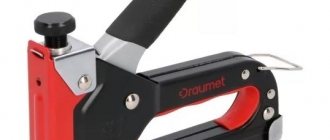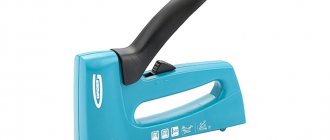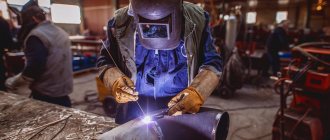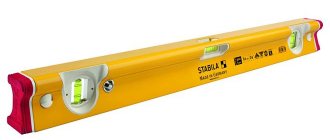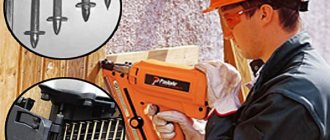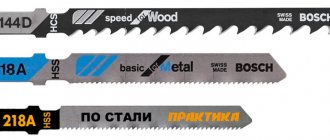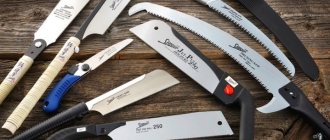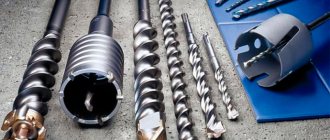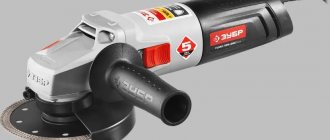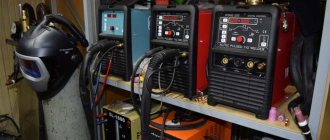Simultaneously with the invention of the office stapler, construction models appeared. Soon the conventional mechanical device was supplemented with an improved electrical version. Both in the office and in construction, the stapler has gained wide popularity. This is a tool that furniture makers cannot do without. If there is a need to purchase this device, then first we will figure out what types of staplers there are and how they differ.
Types of staplers and their purpose
A construction stapler is a device that is used to fasten various materials using special staples. This device is also called a staple gun, staple gun, staple gun, or even a pistol. The tool is popular not only among furniture upholsterers, but also among workers in various fields. It is always useful in the household, because with its help you can quickly and efficiently connect two different parts.
Construction staplers are divided into types based on the type of drive. What they are and how they differ, we will find out further:
- Mechanical is the most common type of device, which is popular not only among home craftsmen. The device is activated by applying physical force. The denser the material into which the staples are hammered, the more effort a person needs to put in. A mechanical stapler is characterized by its small size, low cost and lack of connection to an electrical network or compressor
- Electric - the principle of their operation is the use of electricity. The staples fire when the trigger is lightly pressed. The physical effort required to fire staples in mechanical staplers is replaced by an electric drive. It should be noted that electrical appliances are divided into mains and battery-powered. Mains ones require connection to an outlet, while rechargeable ones are more bulky and require regular battery charging.
- Pneumatic - if mechanical ones use physical force, and electric ones use the force created by an electric motor, then in pneumatic ones, the main drive device is compressed air. This air is supplied from a compressor, so the stapler is tied to the equipment, which makes it inconvenient to use. If electrical and mechanical models are used not only by specialists, but also by home craftsmen, then pneumatic devices are often used only by professionals. The advantage of the tool is its relatively low cost, which is higher than mechanical ones, but less than electric ones.
For home use, a mechanical stapler is sufficient, which, unlike an electric one, can be used in any conditions. Such devices are unpretentious, affordable and provide high reliability of work. It is about manual staplers that will be discussed in the material.
What are the benefits of construction staplers?
- Makes work easier. To hammer a fastener with a stapler, a master will require much less physical effort than when working with a hammer.
- Speed up the work process. Even when using a mechanical stapler, the job progresses faster than using a hammer. With pneumatic and electric tools, you can complete large amounts of work as quickly as possible.
- One-handed operation. Almost all models of staplers require the use of one hand. The second hand is free for auxiliary actions.
- Working in difficult conditions. To drive in fasteners, you do not need to press hard on the tool, which makes it easier to work in an unstable position (for example, on a stepladder), in tight spaces and hard-to-reach places.
- Accurate shot. The instrument transmits kinetic energy very accurately. The risk of damaging the workpiece or making an unsuccessful “shot” is minimal.
- Safety. The design of staplers is designed in such a way that it is simply impossible to get injured if used correctly. All models are equipped with a protective system against inadvertent release of the staple.
- Multifunctionality . Many furniture staplers provide the ability to use different consumables, which allows you to perform diverse tasks.
How does a mechanical device work and the principle of its operation?
The tool in question is activated by applying physical effort. That is why this device is also called a manual stapler. Its design and operating principle differs from that of a stationery device. Construction tools develop a lot of force, which is necessary for fastening or securing materials. According to the design of the drive mechanism, products are divided into two types - with a coil spring and a leaf spring. The main structural elements of a construction stapler:
- Housing - often made of steel, inside which working parts and mechanisms are located. The body has a recess for your hand, which allows you to hold the device during use.
- Handle - connects to the impact mechanism, charging the spring and then firing the staple. It is this handle that the user must exert physical force on to operate the tool.
- The impact mechanism is the basis of the tool, since it is through this device that the staple is fired. The impact mechanism consists of a spring, a hammer, a shock absorber and a striker. The striker acts on the staple, pushing it out and driving it into the material. An integral element of the impact mechanism is also an adjusting screw, through which the force on the bracket is adjusted
- The compartment for installing fasteners is a special channel into which staple cartridges are installed. The ramming mechanism plays an important role in the design of the compartment. This is a special device that pushes the magazine with staples towards the striker as they are used
- Tip - hole through which staples are fed for driving them
- The latch is not the main element of the device, which is intended for transporting the tool. It fixes the handle in an inoperative state, thereby preventing accidental impact on it
A detailed diagram of the structure of a construction stapler is shown in the photo below.
Externally, all mechanical staplers have the same design, but the internal working mechanisms differ in design. The main difference is in the design of the impact mechanism, which is implemented using a conventional coiled and leaf or spring spring. How they differ from each other is described in detail.
- A coil spring staple driver is a common type of stapler that falls under the category of household tools. Their main disadvantage is that they have a large load and recoil force. Long-term use causes physical fatigue in the hands, so the tool is not intended for prolonged use.
The principle of operation of such a stapler is that the handle engages with the striker, thereby moving it upward, overcoming the resistance of the spring. The more the spring is compressed, the stronger the impact on the bracket. When the striker reaches the maximum upper position, it jumps off the handle mount, and thereby it moves downward at high speed, hitting the bracket with the striker. The staple, under the influence of the striker, shoots out of the tip, entering the material. You need to know the operating principle of a construction stapler in order to be able to eliminate its breakdowns when they occur.
- Staple hammer with leaf spring - these staplers belong to the category of professional tools. They are characterized by smooth operation, increased service life, and also higher cost compared to household type staplers. However, this does not mean at all that such a stapler is intended exclusively for professional use. If you plan to use the tool frequently, it is better to take a device with a leaf spring.
The principle of their operation is similar to devices that consist of a coiled spring. When you press the handle, the flat striker moves with simultaneous deformation of the combat plate. As soon as the striker reaches the maximum upper position, it will return to its original position with instantaneous speed. This is achieved due to the fact that the plate tends to take its original position. The hammer, returning downwards, impacts the firing pin, and the latter, in turn, strikes the bracket. Such devices are also equipped with force regulators. They have a more complex design, which is reflected in their cost.
The difference in price between these tools is significant, as is the service life. Before you buy a mechanical stapler for driving staples, you should answer the questions - what is the tool for and how often do you plan to use it.
This is interesting!
You can distinguish a stapler with a coil spring from a device with a plate externally by such a characteristic feature as the location of the adjusting screw. On devices of the first type, the screw is located on top, and on devices of the second type, the adjusting washer is located on the handle.
How to choose a mechanical stapler
A mechanical stapler is one of the most common tools. It costs very little, but is used for many jobs and operations. In terms of structure, mechanical staplers come in two types: with a coil spring and with a spring (plate).
Mechanical stapler with coil spring
Coil spring staplers are the cheapest models. This tool belongs to the household category. They are simple, but during operation they require significant effort to cock the mechanism again. In addition, over time, such springs lose some of their elasticity and begin to work worse. Another unpleasant moment is the high recoil force. Such models are suitable for short-term use - the load is too heavy.
Professional mechanical construction staplers are made using flat leaf springs. They provide smoother operation, less recoil, have a longer service life, but are more expensive.
Mechanical stapler with leaf spring
If you plan to work for several hours, get this type of tool. It will justify itself, and there will be applications - a lot of different operations can be done with such a device. It is especially useful for those who try to do a lot with their own hands. It is used very often during construction, and will come in handy later on the farm.
Important points
When choosing any mechanical stapler, pay attention to:
- The case must be dismountable - with screws. Then it is possible, if necessary, to disassemble it, clean and lubricate it.
- How far is the handle from the body? The closer it is to the body, the easier it will be to work.
- Possibility of adjusting the punching mechanism. When working with soft materials (pine, for example), the minimum value is set. So that the staple fits in, but the material does not jam. When working with hardwood, plywood, chipboard, etc., you will have to put in more effort, otherwise the staples won’t go into the material, and finishing them off with a hammer is not the most fun thing to do.
Please note these must be screws and not rivets - Double strike function available. This is just for working with hard materials. This mode of operation allows you to re-hit a staple that is not completely hammered. In this case, a new one is not supplied.
Also, for safe transportation and storage, it is desirable to have a “stressless release” function or the ability to jam the mechanism - often this is just a metal loop that fits over the handle.
How to refill
A construction stapler can have two types of magazine. It is more convenient to use if the store opens. Then refilling a construction stapler is as simple as a stationery stapler: the spring is pulled back, a block of staples is inserted, and the spring is released. That's it, you can work. During operation, at any time you can remove the stuck bracket, correct the block, etc.
If the magazine is retractable, inserting staples into the stapler is also easy: after releasing the latch, pull out the spring, insert the staple block, return the spring to its place, fixing it in the flap.
How to fill a staple gun with staples
With such a structure, removing a stuck staple can be problematic. You will need to pick it out of the striker, and this can be dangerous - do not forget to block the release mechanism.
What kind of fasteners can it work with?
There are three types of staples that mechanical staplers work with: U- and U-shaped staples and pins (shaped like the letter T). Naturally, it is better if the device can work with all types, but these are usually not cheap models. Yes, and U-shaped brackets are needed mainly when laying cables, and this, you see, is a specific job, and T-shaped ones are used infrequently, since they do not provide stable fastening, but they are indispensable if it is necessary to make the fasteners as inconspicuous as possible.
You also need to choose the type of staples
However, U-shaped staples are most often needed. They are almost universal, available with different back thicknesses and leg heights, and are selected for the type of work. The characteristics of the stapler usually indicate the maximum length of the legs that this unit can handle. On average it is 10-15 mm. By this indicator you can judge the power of the impact - the longer the staples a construction stapler can hammer in, the more powerful it is and the easier it will cope with the job.
Technical characteristics of mechanical staplers
Knowing the structure and operating principle of mechanical type construction staplers, it is also necessary to understand their basic design characteristics. These characteristics include:
- Material - what the stapler body is made of. The most commonly used material is steel, while cheaper options are made from aluminum alloy. The simplest are products made of impact-resistant plastic, but they are not intended for frequent and prolonged use. The handle of steel and aluminum staplers can be covered with a rubber or polyurethane layer
- Dimensions and weight - all mechanical staplers are compact, so there are no difficulties with their storage and transportation. The length of the devices ranges from 155 mm to 230 mm, and the height varies from 120 to 200 mm. The width of 25-35 mm not only characterizes the dimensions of the tool, but also the possibility of using staples of different sizes. Hand-held models weigh from 300 to 800 grams, and if the device body is plastic, then their weight is even less
- Impact force - this parameter for manual staplers is the lowest compared to electric ones, and even more so, pneumatic ones. The impact force is regulated by a special screw, which is equipped with all models of staplers
- Impact frequency or rate of fire - this parameter is measured in the number of staples driven in one minute. For hand tools this figure is the lowest. Electric models show the following results - from 20 to 50 staples per minute, and the most highly productive are pneumatic counterparts, which fire 50-60 times per minute
- The depth of driving the staples - this parameter depends on the impact force of the tool, as well as the type of material for driving the staples. Mechanical staplers are capable of driving 10-15 mm staples, while their modern rivals, electric and pneumatic devices, can handle 50 and even 100 mm fasteners. However, on the farm there is rarely a need to connect various parts using such long staples, especially since it is much more reliable to make the connection using self-tapping screws
It should be noted that manual staplers are designed for driving staples into hard surfaces. Often these are wood, plywood and plastic. The need to use a stapler arises when there is a need to attach woven materials to solid substrates. In addition to the fact that the stapler copes with this task quickly, the resulting result is also decorative, which is why these tools are widely used in the field of furniture construction and repair.
Unlike mechanical devices, electrical and especially pneumatic devices allow you to attach soft materials to hard ones, and even provide a connection between two hard surfaces. For such purposes, staples of appropriate thickness and strength are used. We will learn further about what types of staples for construction staplers are produced.
Working with a mechanical stapler
To learn how to carry out repair work using a construction stapler, you need to know about the basic rules of this process.
Charging the device
Before you start, for example, upholstering a sofa, it’s worth learning how to charge a stapler. This is done step by step according to the following algorithm:
- Installing the device on the fuse.
- A folding flap at the rear of the stapler reveals a compartment for staples.
- Pulling the rod with the spring out of the compartment.
- Installing staples with the upper bent part towards the handle of the stapler.
- Releasing the rod to clamp them.
- Slam the sash until it clicks and start working.
Some models have a different mechanism and therefore many people think about how to refill them. There is nothing complicated here either, just remove the special chute that appears when you press the button. The staples are installed into it with their sharp ends down. Afterwards the filled element is inserted back.
The process of charging a mechanical stapler with staples
We attach the staples to the base
After clarifying the charging instructions, it will not be amiss to find out how to use the stapler during direct work.
This is done like this:
- Prepare materials for fixation and the instrument itself.
- Mark the line along which the staples will be attached. This makes it easier to install fasteners exactly in the place where you plan.
- The stapler is applied to the desired place quite firmly.
- Without lifting the device from the surface, press the lever.
- After this, if everything is done correctly, a characteristic sound will be heard, and the bracket will be securely attached to the base.
Staple fixation process
Material for making staples for a stapler
Manufacturers produce staples from various materials, which allows them to expand their scope of application. They come in the following types:
- Aluminum - used for working with non-solid types of materials
- Copper - these staples are also called decorative, as they are intended for covering furniture with various types of fabrics
- Steel ones are the most popular and inexpensive. They can be used for driving not only into soft, but also hard materials. The main disadvantage is that they rust over time.
- Stainless - made of stainless steel, and used when it is necessary to prevent the occurrence of corrosion processes
Additional zinc coating of the brackets eliminates the occurrence of corrosion processes. When choosing fasteners of the appropriate material, it is necessary to take into account what you plan to connect.
Fasteners for staplers according to shape
Staples for construction staplers come in different shapes, which is done specifically in order to expand the scope of their application. The following varieties are distinguished:
- U-shaped
- U-shaped
- T-shaped
U-shaped and U-shaped staples have almost the same shape, but their scope of application is radically different. U-shaped devices are the most popular and are used almost everywhere. U-shaped devices are used in the field of electrical work. With their help, cable lines are secured during their installation. T-staples are an alternative replacement for nails, but they don't require you to hit the head dozens of times to get it into the surface. A distinctive feature of T-shaped staples from nails is that the former have a rectangular or square head shape.
Recommendations for repairing the device
Using the stapler is convenient and pleasant. The staples are installed in a special magazine, the device is pressed to the desired location and the lever is pressed. The bracket is now secured. But sometimes trouble happens - the stapler breaks. The bracket does not fly out from behind the charger; only a dent from the striker remains in the place where they tried to install it. This means that the stapler needs inspection, which is most often followed by repair. To carry out repairs, disassemble the device in a certain sequence:
- remove the adjusting screw;
- remove the spring;
- remove the protective casing;
- remove the pins and lock washers.
To get the stapler into working condition, you will need the following tools:
- screwdriver;
- pliers;
- hammer;
- file;
- vice.
When everything unnecessary is removed, you can see what happened to the drummer. Most often, the cause of failure is the fact that the hammer body has worn out the thrust element. With its help, the interaction of the impact mechanism and the trigger lever is ensured.
The drummer is the main working part of this device. A special spring exerts powerful pressure on it; if necessary, its force can be adjusted using a special screw.
Types of stapler staples.
An element called a charging carabiner is fixed to the impact device at an angle of 90 degrees. It contains brackets, which are subject to the action of the spring. When not in use, the brackets are closed by a plate attached to the body.
The correct operation of the charging device, coupled with the striking element, depends on the serviceability of the trigger system. It consists of the following parts:
- lever, cocking mechanism;
- strong spring;
- a part called a “rocker arm”.
In order to drive the staple, you must press the lever forcefully. The hammer will rise under the action of the rocker arm. The bracket passes into the striker mechanism, and the compression of the spring stops. The striker hits the bracket with force, it goes into the base.
Looking carefully at the working process of a construction stapler, we can conclude that the main criterion for its good operation will be several interacting operations: the cocking of the impact element and the unhindered exit of the staples.
The drummer must work with the rocker in synchronized mode. If this is not the case, the person working with the stapler will press the lever in vain. Something akin to a blank shot occurs. The trigger is cocked, then it fires, but the firing pin does not engage the bracket. This is exactly how the device works when the thrust element wears out at the protrusion of the firing pin.
Repairing the device is not particularly difficult and does not take much time. The drummer is clamped in a vice. Then, using a simple file, the protrusion is sharpened and given its original shape. Such actions help to significantly increase the operating time of the tool. This operation will need to be carried out regularly - it must be performed immediately as soon as the pistol begins to fire inappropriately. It should be borne in mind that since the striker plate will need to be constantly slightly sharpened, it will gradually shorten.
The hardness of staples and what it affects
The greater the hardness of the consumable, the higher the efficiency of its penetration into the surface of the driven material. To understand why staples of different hardnesses are produced, you need to imagine a picture when it is necessary to drive a staple into a board made of hard wood. A soft aluminum or copper staple will not penetrate the surface of such wood. The result is a damaged bracket with bent legs. To prevent this from happening, manufacturers produce consumables with the following hardness names:
- Simple
- Very hard
- Red-hot
A description of the degree of hardness of the staples is presented in ascending order. The ends of the devices may have additional sharpening, which allows for effective insertion of the part into the surface of solid materials with the least resistance.
Dimensions of fasteners for construction staples, their purpose and application
Often, when purchasing a mechanical stapler, a set of staples is included with it. These devices come in different sizes, which must be considered depending on their application. Moreover, they differ not only in the length of the back and the height of the legs, but also in thickness. When purchasing them, you can see that the packaging contains the following designations:
- a—thickness
- b - width
The most popular types of staples are the following:
- 53 is the most common version of products, which have a thickness of 0.7 mm and a width of 11.4 mm. Leg height from 4 to 14 mm is selected depending on the task at hand
- 140 - such products have a thickened shape of 1.2 mm with a back width of 10.6 mm. The height of the legs also ranges from 4 to 14 mm
- 36 - this marking indicates that the package contains U-shaped brackets for securing the cable
- 300 are nails for a special staple gun
Below is a table of staple sizes from different manufacturers.
Repair
Like any other tool, a stapler can fail. The most common malfunction is the breakdown of the impact mechanism. You should not immediately run to the workshop, since you can bring the device back to life yourself. To do this you need:
- remove the adjustment screw;
- remove the spring;
- remove the protective cover;
- remove the pins;
- remove the washers;
- remove the striker;
- place in a vice;
- give the striker its original shape.
That's all. The device is in full combat readiness. This is one of the most common causes of malfunction (loss of impact force and bending of the bracket).
How to use a construction stapler correctly
Before using the tool, you must first select the appropriate type of brackets and install them in the device compartment. To charge a new fastener, the following manipulations are carried out:
- The first step is to block the device handle from accidentally pressing it.
- At the back of the tool there is a special hatch with a rod and a pusher (removal mechanism), when removed, a compartment opens for installing a cartridge cassette of staples
- The cassette is installed inside the compartment, turning it so that the legs point down
- Next, we return the ramming mechanism to its place, thereby pressing the staples
- The handle is removed from the safety lock
- The tool is ready for use. Now you can make a few test shots to make sure the device is working.
In a similar sequence, staples of different sizes and shapes are installed or charged. However, before installing the appropriate fasteners into the tool, you must make sure that it is designed to work with them.
After this, you can begin to use the construction stapler for its intended purpose. It is not difficult to work with a furniture stapler, and the only regulator is to adjust the impact force. If, when you try to drive in the staple, it does not go in all the way, then you need to rotate the adjuster in a clockwise direction. If the fastener is deeply recessed inside the material, then it is necessary to loosen the spring pressure.
This is interesting!
When the staples in the gun run out, it is not recommended to click the handle idle.
The mechanism of the tool wears out with each blow, so the device will not last long in this case. Features of adjusting the impact force for household and professional staplers:
- Features of setting household staplers - tightening the screw clockwise helps compress the spring. As a result, the staples are fired with greater force, which will also contribute to its penetration deeper into the material. If you turn the regulator in the opposite direction, the blow will be weaker
- Setting up a professional stapler - the regulator is located near the handle. When it rotates, the impact force also increases or decreases. The tool needs adjustment every time the material being processed is changed.
The tool is considered to be correctly adjusted when the staple is completely inserted into the material. You should start using the tool only after the impact force has been correctly adjusted.
This is interesting!
Often, during the operation of a furniture stapler, a situation arises when the staple does not completely enter the material. The reason for this phenomenon is that the spring wears out. If you adjust the impact force of the screw to the maximum value, and the fasteners do not go in completely, then the tool needs repair.
What can you do with a construction stapler?
Construction and furniture production are two industries where construction staplers are in greatest demand. They are also actively used in carpentry and interior design. Staplers are used by florists, decorators, and packers. And in a home workshop, it wouldn’t hurt to have a simple household staple gun. After all, on the farm, there is also often a need to firmly attach something, cover it with fabric or nail it.
Here is a partial list of operations that can be performed using a staple gun:
- covering furniture structures and frames with upholstery materials;
- formation of draperies with fixation of folds and gathers;
- stretching posters and canvases onto frames;
- fastening sheet materials to various bases;
- installation of roofing materials (for example, roofing felt);
- installation of insulation, insulating materials, films;
- covering surfaces with siding, lining, decorative panels;
- laying carpets;
- production of packaging, shipping pallets, lathing;
- assembly of greenhouses and film greenhouses;
- nailing window and door beads;
- fixing cables.
Wide possibilities, isn't it? A construction stapler is truly a multi-purpose and functional tool.
Which construction stapler is better?
Today, a lot of construction staplers are produced, which differ not only in their external design features. They differ in performance and resource. However, one can argue with these words, because the duration of the resource depends on the features of using the tool. Before you buy a construction stapler for your home, it is recommended that you familiarize yourself with the popular models that received the highest rating in the rating - inexpensive and high quality. You can choose which construction stapler is better by yourself by familiarizing yourself with the models presented below:
- STAYER 31510 is an inexpensive and very effective household type stapler. Despite the German name, this instrument is produced in China. It is distinguished by high reliability and reliability. Reviews show that the device is resistant to various negative impacts - falls and shocks. The handle has a rubberized layer, which eliminates the possibility of calluses forming during prolonged use of the tool.
- The whirlwind is a very powerful tool that can cope with any complexity of housework. It is used not only for upholstering furniture, but also for fastening sheet materials. It has a high impact force, which allows it to pierce plywood. This powerful household tool weighs 500 grams, which can be called a disadvantage. Another drawback is the rigidity of the handle, due to which greater impact force is achieved. Reviews show that the resource of the tool with frequent use is quite long, and if you need a reliable stapler, then you should take a closer look at the models from the Vikhr company
- Gigant is another reliable staple gun from the Chinese manufacturer. It has a simple design, which has a positive effect on its cost. The body material is coated with chrome, which ensures reliable protection against corrosion. Impact mechanism made of tool hardened steel ensures long service life of the tool
It should be noted that when choosing, one should take into account such a factor as cost. The higher the price for a particular model, it means the tool is made of higher quality materials and will last longer. If you once had to work with an electric stapler, then you are unlikely to consider mechanical models. However, it makes no sense to buy an electric staple gun if you plan to use it no more than a few times a month. If a mechanical stapler malfunctions, it will not be difficult to disassemble it and repair it yourself.
Advantages and disadvantages of mechanical staplers
Speaking about the advantages of mechanical staplers, we can point out the following:
-low cost;
-light weight;
- ease of operation;
-no need to connect the tool to the power supply.
The disadvantages of mechanical devices include:
-use of manual labor and muscular strength to operate a tool. If the amount of work is large, then it is very tiring;
- the functional features of a mechanical stapler do not allow it to work with high productivity;
- a relatively small number of fasteners that can be inserted into the stapler at a time. That is, the device will have to be charged frequently.
Do-it-yourself repair of a construction stapler
Often during the operation of tools, their malfunction occurs. A mechanical stapler is no exception, repair of which may be required soon after purchase if the cheapest option is purchased.
Let's look at the features of repairing a furniture stapler using the example of a malfunction when two staples shoot out.
Why does the stapler shoot two staples, and is it possible to fix such a breakdown? First we need to figure out why it shoots two fasteners. The reason for this malfunction is the weakening of the clamping force of the staple cassette. The pressure is provided by the rammer. Over time, the spring loses its clamping properties, which leads to a defect when the device fires two staples at once.
You can fix this in the following way:
- For staplers with a spring type of spring, make a U-shaped plate and place it between the latch and the rammer. Such a plate will eliminate free movement of the rammer, and as a result the stapler will hit exactly one staple
- For staplers with coil springs, increase the force of the rammer spring. This can be done by adding spacers in the form of washers
A detailed description of the mechanical stapler repair process is presented in the video material.
No less popular is the problem when staples do not fly out of the stapler.
If in the first case the problem is solved without the need to disassemble the device, then here you cannot do without it. It is easy to disassemble the stapler, depending on its model. To do this, remove the cotter pin washers, and then disassemble the tool. Next you need to get to the impact mechanism, since the malfunction is associated with it. Repairing a construction stapler with a malfunction such as staples not firing is as follows:
- The sides of the striker are inspected
- There should be no licked areas where they come into contact with the handle. The presence of such indicates that the striker does not move to the upper position, but jumps off almost immediately when you press the handle
- The licked areas of the edges must be ground off with a grinder, after which we can assume that the tool has been repaired
- All that remains is to assemble it and check the proper functioning
Another type of failure of a mechanical stapler is when the staple shoots out in the shape of the letter “M”.
This type of fastening is not reliable, so the problem must be corrected as quickly as possible. We will consider the reasons for this malfunction and the features of its elimination below:
- If the staples jam in the shape of the letter “M”, then the reason is the development of the striker
- The firing pin is a plate that is connected to the firing pin
- This type of breakdown often occurs due to the fact that the firing pin is made of low quality steel. With prolonged use of the tool, abrasion of the end part of the striker occurs, which contributes to the creasing of staples in the shape of the letter “M”
- Alignment of the striker is carried out using a fine-grain file
- It is important to take into account that it is not recommended to remove a large amount of edge from the striker, as this will affect the reduction in impact force
After repairing the construction stapler, you can continue to use it. The instrument in question is distinguished by its versatility, for which it has gained wide popularity. In conclusion, it should be noted that, like any other type of tool, a furniture stapler needs lubrication. The impact mechanism is lubricated with lithol or grease, which reduces friction and therefore increases the service life of the device.
Why doesn't the furniture stapler work?
The main malfunctions of a furniture stapler may be associated with improper operation, selection of staples, or design features of a particular model:
- If the staples are not completely clogged, then you need to either adjust the tool and tighten the spring, or remove the jammed staple from the magazine and continue working.
- Often, if the staples are not clogged at all, you need to lubricate the head of the staple clamping mechanism.
- When the staple gun produces several staples at a time or they constantly get stuck, this indicates a malfunction of the striker. Its shape may be damaged or there may be a crack.
Why does a furniture stapler bend staples?
Another common problem is the situation in which a furniture stapler bends the staples; every experienced craftsman knows what to do. The problem can be solved in two ways:
- Purchasing more durable staples, since the existing ones do not match the density of the material.
- Using staples with shorter legs. The shorter they are, the easier it will be for the fastening material to enter the surface.
